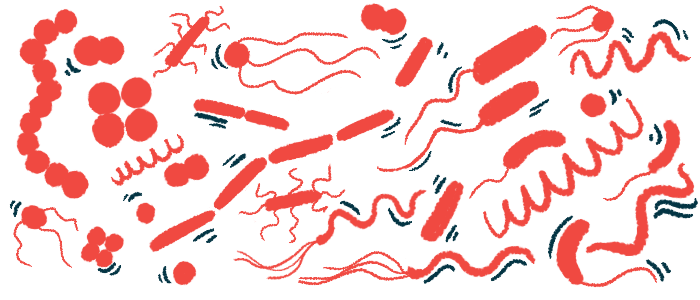New target may aid antibiotics in treating M. abscessus infection
Treatments aimed at enzyme and its pathway largely restored CF organoids

A newly identified therapeutic target showed a potential to enhance the effectiveness of antibiotics against resistant Mycobacterium abscessus (Mabs) lung infection, a damaging complication in people with cystic fibrosis (CF), researchers report.
Experiments using human airway organoids derived from CF patients also accurately reflected many features seen in their lungs.
“Here we adapted the human airway organoid technology to model Mabs infection in the context of CF, [and] decipher mechanisms of host-pathogen interaction that can be pharmacologically targeted to improve infection control,” the researchers wrote in the study, “Druggable redox pathways against Mycobacterium abscessus in cystic fibrosis patient-derived airway organoids.” It was published in the journal PLOS Pathogens.
Bacterial CF lung infections can be damaging and difficult to treat
M. abscessus infection is a serious complication in people with CF, primarily because of its resistance to several antibiotics. However, what drives such infections in CF patients is largely unknown.
While animal models have helped to understand M. abscessus lung infection, they do not accurately mimic many of the disease’s hallmarks in people.
Airway organoids are self-organized 3D structures derived from adult stem cells found in lung tissue, and they share many essential characteristics with human bronchial airways. Organoids derived from CF patients also recapitulate several aspects of the disease that cannot be achieved with animal models.
Researchers in France and the Netherlands recently demonstrated that M. abscessus growth in airway organoids is a suitable system to help understand what drives such infections among the public. Now, the team characterized M. abscessus infections using organoids derived from CF patients.
“Of particular interest, organoids derived from CF patients constitute a unique system to model natural CFTR mutations and the resulting epithelium dysfunctions such as exacerbated mucus secretion,” the scientists wrote.
Airway organoids form circular-like structures, with the inside mimicking the bronchial airway tube (lumen) and lined with cells found on airway surfaces, including basal, ciliated, and goblet cells.
Researchers first exposed organoids derived from healthy individuals with smooth and rough variants of M. abscessus. The smooth variant forms biofilms and is common in the environment, while the rough variant forms cord-like structures and is known to be more aggressive; this variant is associated with lung disease in CF patients.
M. abscessus morphs in CF airways to become more highly virulent
Both variant types grew well within the lumen of the organoids, with the smooth variants growing better than the rough variants after four days. Still, cell death was higher in organoids infected with the rough variant than the smooth variant, “likely reflecting the higher virulence of the cord-forming R [rough] morphotype,” the team wrote.
Infection also triggered a decrease in the activity of genes coding for pro-inflammatory signaling proteins — the exception was CXCL10, which increased — while reducing the production of mucus proteins.
At the same time, the rough variant, but not the smooth variant, led to reactive oxygen species (ROS) production, which cells can use to kill microbes via oxidative stress. But excessive oxidative stress — a cellular imbalance between free radicals and antioxidants — damages tissues. When infected airway organoids were exposed to two antioxidants to counter oxidative stress, the growth of both variants fell by 70%.
“ROS production is a part of host antimicrobial defence but requires a fine-tuned balance to prevent tissue damage,” the scientists wrote. Based on the findings, “airway epithelial cells mount an oxidative response upon Mabs infection, which contributes to Mabs growth and virulence.”
Consistent with CF airways, airway organoids derived from CF patients showed mucus accumulation in the lumen. ROS production also was higher in these CF organoids than in healthy and uninfected airway organoids.
After infection, both variants grew better in CF organoids than healthy ones, with a higher percentage of rough variants. Infected CF organoids also exhibited higher oxidative stress and more cell death than infected healthy organoids, especially with the rough variant. Researchers also confirmed that M. abscessus bacteria itself generated ROS.
Bacterial load fell with antioxidant targeting NQO1 enzyme and its pathway
CF organoids then were treated with the antioxidant sulforaphane, which enhanced the production of an antioxidant enzyme called NQO1 via the NRF2 pathway. Treatment reduced M. abscessus bacterial load by 80%, with fewer organoids containing rough-variant cords and showing less cell death.
Blocking NQO1 activity abolished sulforaphane’s effect on bacterial growth and cording, “indicating that NQO1 might play a protective role during Mabs infection,” the scientists wrote.
Finally, use of the antibiotic cefoxitin also significantly inhibited Mabs growth by 92% in CF airway organoids. With the addition of sulforaphane, bacterial load fell even further to 99%.
“We have established AOs [airway organoids] as a pertinent model of both CF airway dysfunction and susceptibility to Mabs infection,” the researchers concluded. “Moreover, we have identified the cell protective NRF2-NQO1 axis as a potential therapeutic target to restore CF tissue [oxidative balance] and improve the control of bacteria growth.”








